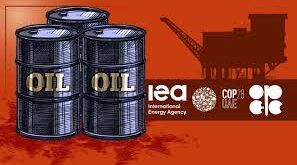Oil is among the biggest commodity gainers in 2019. with prices up by more than 20% — a testament to the success of the output cuts agreed to by major crude producers at the start of the year.
However. the cuts eventually may run head-on into the effects of increased U.S. shale production and more output from other sources. That could test the resolve of some members of the Organization of the Petroleum Exporting Countries. as well as their nonmember allies. which include Russia.
“High compliance with the OPEC production cuts is impressive and clearly a significant driver of the rally in crude oil futures.“ says Marshall Steeves. energy markets analyst at Informa Economics. But outside of the Persian Gulf producers like Saudi Arabia. compliance with output reductions “may not necessarily remain high over time.“ he says.
OPEC members agreed to trim 800.000 barrels a day from October’s production levels for six months through June of this year. with Russia and other allied producers cutting another 400.000 barrels a day to total 1.2 million barrels in cuts.
Saudi Arabia’s Energy Minister Khalid al-Falih recently told Reuters that it would be too early to change that pact before OPEC and its allies meet in June. The next official OPEC and non-OPEC meetings will be held on April 17 and 18. The Joint Ministerial Monitoring Committee. which monitors compliance with output cuts. will hold its next gathering on Monday. March 18.
The 11 OPEC members under the quotas achieved 79% of their committed cuts in February. with OPEC’s production at 30.8 million barrels a day. according to a survey conducted by S&.P Glpbal Platts. That’s an improvement from the 76% compliance rate a month earlier.
Year to date. U.S. CLJ9. -0.10% and global oil futures LCOK9. -0.55% have rallied by more than 20% as of Thursday after dropping by 20% or more in 2018.
The commitment to the cuts is surprising given OPEC concerns over the loss of market share to other producers such as the U.S. Crude production from the U.S. hit a record. above 12 million barrels a day in recent weeks. and the International Energy Agency expects the U.S. to lead the rise in global oil production over the next five years.
The IEA projection “suggests the current trend of unconventional shale production and offshore Gulf of Mexico production growth will likely continue at the expense of OPEC and allied producers.“ says Steeves. “If OPEC and its allies want to keep oil prices high. they will need to curtail supplies. meaning they will continue to lose market share to the U.S. and others.“
Still. not everyone is convinced that shale production will grow at a significant pace. “While I do see U.S. production growing. shale is expensive.“ says Matt Badiali. senior research analyst at Banyan Hill Publishing. “Operators can exist at $50-$55 per barrel. but they aren’t making much money — and they need credit to operate. So as interest rates rise. it will likely slow U.S. production growth.“
Oil prices ‘have found a balance that could eventually prove precarious’ with OPEC-led production cuts supporting higher prices. but increased output from the U.S. and elsewhere ‘keeping a lid on the market.’ Marshall Steeves. Informa Economics
For now. oil prices “have found a balance that could eventually prove precarious.“ with OPEC-led production cuts supporting higher prices. but increased output from the U.S. and elsewhere “keeping a lid on the market.“ Steeves says.
He expects U.S. benchmark West Texas Intermediate crude to trade in the mid-to-upper $50s in the next 30 to 60 days. with a wider range of $48-to-$68 a barrel. while Brent trades in the upper $60s. within a wider range of $50-to-$70.
“What could break the impasse amounts to either a quick rebalancing of global markets that could raise prices or signs of slower global economic growth that could lead to lower oil prices.“ says Steeves.
 Iran Energy News Oil, Gas, Petrochemical and Energy Field Specialized Channel
Iran Energy News Oil, Gas, Petrochemical and Energy Field Specialized Channel




